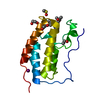[English] 日本語
 Yorodumi
Yorodumi- PDB-9sai: Ternary PROTAC-mediated complex consisting of Cereblon, DDB1 and ... -
+ Open data
Open data
- Basic information
Basic information
| Entry | Database: PDB / ID: 9sai | ||||||
|---|---|---|---|---|---|---|---|
| Title | Ternary PROTAC-mediated complex consisting of Cereblon, DDB1 and BRD4-BD1, non-covalently linked by JQ1-AcN | ||||||
 Components Components |
| ||||||
 Keywords Keywords | LIGASE / ternary complex / PROTAC / cereblon | ||||||
| Function / homology |  Function and homology information Function and homology informationnegative regulation of monoatomic ion transmembrane transport / positive regulation by virus of viral protein levels in host cell / spindle assembly involved in female meiosis / epigenetic programming in the zygotic pronuclei / UV-damage excision repair / biological process involved in interaction with symbiont / regulation of mitotic cell cycle phase transition / WD40-repeat domain binding / Cul4A-RING E3 ubiquitin ligase complex / Cul4-RING E3 ubiquitin ligase complex ...negative regulation of monoatomic ion transmembrane transport / positive regulation by virus of viral protein levels in host cell / spindle assembly involved in female meiosis / epigenetic programming in the zygotic pronuclei / UV-damage excision repair / biological process involved in interaction with symbiont / regulation of mitotic cell cycle phase transition / WD40-repeat domain binding / Cul4A-RING E3 ubiquitin ligase complex / Cul4-RING E3 ubiquitin ligase complex / Cul4B-RING E3 ubiquitin ligase complex / ubiquitin ligase complex scaffold activity / negative regulation of reproductive process / negative regulation of developmental process / locomotory exploration behavior / RNA polymerase II C-terminal domain binding / cullin family protein binding / P-TEFb complex binding / viral release from host cell / negative regulation of DNA damage checkpoint / histone H4 reader activity / host-mediated suppression of viral transcription / positive regulation of G2/M transition of mitotic cell cycle / positive regulation of Wnt signaling pathway / ectopic germ cell programmed cell death / positive regulation of T-helper 17 cell lineage commitment / negative regulation of protein-containing complex assembly / positive regulation of viral genome replication / proteasomal protein catabolic process / : / positive regulation of gluconeogenesis / RNA polymerase II CTD heptapeptide repeat kinase activity / condensed nuclear chromosome / transcription coregulator activity / nucleotide-excision repair / positive regulation of protein-containing complex assembly / positive regulation of transcription elongation by RNA polymerase II / Recognition of DNA damage by PCNA-containing replication complex / regulation of circadian rhythm / DNA Damage Recognition in GG-NER / Dual Incision in GG-NER / Transcription-Coupled Nucleotide Excision Repair (TC-NER) / Formation of TC-NER Pre-Incision Complex / Formation of Incision Complex in GG-NER / Wnt signaling pathway / Dual incision in TC-NER / Gap-filling DNA repair synthesis and ligation in TC-NER / positive regulation of protein catabolic process / cellular response to UV / p53 binding / rhythmic process / chromosome / site of double-strand break / Neddylation / regulation of inflammatory response / ubiquitin-dependent protein catabolic process / protein-macromolecule adaptor activity / histone binding / Potential therapeutics for SARS / proteasome-mediated ubiquitin-dependent protein catabolic process / damaged DNA binding / transmembrane transporter binding / transcription coactivator activity / chromosome, telomeric region / positive regulation of canonical NF-kappaB signal transduction / transcription cis-regulatory region binding / protein ubiquitination / chromatin remodeling / DNA repair / protein serine/threonine kinase activity / apoptotic process / DNA damage response / chromatin binding / regulation of transcription by RNA polymerase II / negative regulation of apoptotic process / chromatin / positive regulation of DNA-templated transcription / protein-containing complex binding / nucleolus / perinuclear region of cytoplasm / enzyme binding / positive regulation of transcription by RNA polymerase II / protein-containing complex / extracellular space / DNA binding / extracellular exosome / nucleoplasm / metal ion binding / nucleus / membrane / cytoplasm / cytosol Similarity search - Function | ||||||
| Biological species |  Homo sapiens (human) Homo sapiens (human) | ||||||
| Method | ELECTRON MICROSCOPY / single particle reconstruction / cryo EM / Resolution: 2.66 Å | ||||||
 Authors Authors | Fischer, G. / Peter, D. / Arce-Solano, S. / Kessler, D. | ||||||
| Funding support | 1items
| ||||||
 Citation Citation |  Journal: J Am Chem Soc / Year: 2025 Journal: J Am Chem Soc / Year: 2025Title: Enzyme-Activated Sugar-Coated Bifunctional Degraders. Authors: Qian Zhu / Gerhard Fischer / Steven S Cheng / N Connor Payne / Daniel Peter / Alison C Mody / Silvia Arce-Solano / Dacheng Shen / Zhi Lin / Ralph Mazitschek / Dirk Kessler / Christina M Woo /   Abstract: Targeted protein degradation with compounds like proteolysis targeting chimeras (PROTACs) directs disease-associated proteins to the E3 ligase ubiquitin-proteasome system for removal. However, ...Targeted protein degradation with compounds like proteolysis targeting chimeras (PROTACs) directs disease-associated proteins to the E3 ligase ubiquitin-proteasome system for removal. However, commonly employed E3 ligases such as cereblon (CRBN) are broadly expressed. To metabolically gate PROTAC activity, we developed an enzymatic activation strategy by integrating an O-GlcNAc modification to the cyclimids, ligands derived from the natural motifs recognized by CRBN. These sugar-coated PROTACs (SCPs) were designed using structural analyses of representative cyclimid degraders complexed with CRBN and target protein BRD4. We found that glycosylation of the cyclimid reduced CRBN binding and complex formation with BRD4 until enzymatic removal of the O-GlcNAc moiety by O-GlcNAcase (OGA). The requirement for enzymatic activation is demonstrated by biochemical binding, cellular degradation, and cell viability assays in engineered and native cell lines. O-GlcNAc is thus an effective mechanism to gate targeted protein degradation modalities that motivates the development of similar strategies to enhance selectivity with other protein modifications. | ||||||
| History |
|
- Structure visualization
Structure visualization
| Structure viewer | Molecule:  Molmil Molmil Jmol/JSmol Jmol/JSmol |
|---|
- Downloads & links
Downloads & links
- Download
Download
| PDBx/mmCIF format |  9sai.cif.gz 9sai.cif.gz | 282.1 KB | Display |  PDBx/mmCIF format PDBx/mmCIF format |
|---|---|---|---|---|
| PDB format |  pdb9sai.ent.gz pdb9sai.ent.gz | Display |  PDB format PDB format | |
| PDBx/mmJSON format |  9sai.json.gz 9sai.json.gz | Tree view |  PDBx/mmJSON format PDBx/mmJSON format | |
| Others |  Other downloads Other downloads |
-Validation report
| Summary document |  9sai_validation.pdf.gz 9sai_validation.pdf.gz | 1.6 MB | Display |  wwPDB validaton report wwPDB validaton report |
|---|---|---|---|---|
| Full document |  9sai_full_validation.pdf.gz 9sai_full_validation.pdf.gz | 1.7 MB | Display | |
| Data in XML |  9sai_validation.xml.gz 9sai_validation.xml.gz | 50 KB | Display | |
| Data in CIF |  9sai_validation.cif.gz 9sai_validation.cif.gz | 74 KB | Display | |
| Arichive directory |  https://data.pdbj.org/pub/pdb/validation_reports/sa/9sai https://data.pdbj.org/pub/pdb/validation_reports/sa/9sai ftp://data.pdbj.org/pub/pdb/validation_reports/sa/9sai ftp://data.pdbj.org/pub/pdb/validation_reports/sa/9sai | HTTPS FTP |
-Related structure data
| Related structure data |  54691MC  9safC  54890  54891 M: map data used to model this data C: citing same article ( |
|---|---|
| Similar structure data | Similarity search - Function & homology  F&H Search F&H Search |
- Links
Links
- Assembly
Assembly
| Deposited unit | 
|
|---|---|
| 1 |
|
- Components
Components
| #1: Protein | Mass: 50559.559 Da / Num. of mol.: 1 Source method: isolated from a genetically manipulated source Source: (gene. exp.)  Homo sapiens (human) / Gene: CRBN, AD-006 / Production host: Homo sapiens (human) / Gene: CRBN, AD-006 / Production host:  unidentified baculovirus / References: UniProt: Q96SW2 unidentified baculovirus / References: UniProt: Q96SW2 |
|---|---|
| #2: Protein | Mass: 93347.078 Da / Num. of mol.: 1 Source method: isolated from a genetically manipulated source Details: beta-propeller B removed,beta-propeller B removed,beta-propeller B removed,beta-propeller B removed,beta-propeller B removed,beta-propeller B removed,beta-propeller B removed,beta-propeller B removed Source: (gene. exp.)  Homo sapiens (human) / Gene: DDB1, XAP1 / Production host: Homo sapiens (human) / Gene: DDB1, XAP1 / Production host:  unidentified baculovirus / References: UniProt: Q16531 unidentified baculovirus / References: UniProt: Q16531 |
| #3: Protein | Mass: 15099.380 Da / Num. of mol.: 1 Source method: isolated from a genetically manipulated source Source: (gene. exp.)  Homo sapiens (human) / Gene: BRD4, HUNK1 / Production host: Homo sapiens (human) / Gene: BRD4, HUNK1 / Production host:  |
| #4: Chemical | ChemComp-ZN / |
| #5: Chemical | ChemComp-A1JM3 / Mass: 723.285 Da / Num. of mol.: 1 / Source method: obtained synthetically / Formula: C35H43ClN8O5S / Feature type: SUBJECT OF INVESTIGATION |
| Has ligand of interest | Y |
| Has protein modification | N |
-Experimental details
-Experiment
| Experiment | Method: ELECTRON MICROSCOPY |
|---|---|
| EM experiment | Aggregation state: PARTICLE / 3D reconstruction method: single particle reconstruction |
- Sample preparation
Sample preparation
| Component | Name: Ternary PROTAC-mediated complex consisting of Cereblon, DDB1 and BRD4-BD1, non-covalently linked by JQ1-AcN Type: COMPLEX / Entity ID: #1-#3 / Source: RECOMBINANT | ||||||||||||||||
|---|---|---|---|---|---|---|---|---|---|---|---|---|---|---|---|---|---|
| Molecular weight | Experimental value: NO | ||||||||||||||||
| Source (natural) | Organism:  Homo sapiens (human) Homo sapiens (human) | ||||||||||||||||
| Source (recombinant) | Organism:  unidentified baculovirus unidentified baculovirus | ||||||||||||||||
| Buffer solution | pH: 7.5 / Details: 20 mM HEPES, 100 mM NaCl, 0.25 mM TCEP, pH: 7.5 | ||||||||||||||||
| Buffer component |
| ||||||||||||||||
| Specimen | Conc.: 0.3 mg/ml / Embedding applied: NO / Shadowing applied: NO / Staining applied: NO / Vitrification applied: YES / Details: complex purified via size exclusion chromatography | ||||||||||||||||
| Specimen support | Details: QF-1.2/1.3-3C AuFoil / Grid material: GOLD / Grid mesh size: 300 divisions/in. / Grid type: UltrAuFoil R1.2/1.3 | ||||||||||||||||
| Vitrification | Instrument: FEI VITROBOT MARK IV / Cryogen name: ETHANE / Humidity: 95 % / Chamber temperature: 277 K |
- Electron microscopy imaging
Electron microscopy imaging
| Experimental equipment |  Model: Titan Krios / Image courtesy: FEI Company |
|---|---|
| Microscopy | Model: TFS KRIOS |
| Electron gun | Electron source:  FIELD EMISSION GUN / Accelerating voltage: 300 kV / Illumination mode: FLOOD BEAM FIELD EMISSION GUN / Accelerating voltage: 300 kV / Illumination mode: FLOOD BEAM |
| Electron lens | Mode: BRIGHT FIELD / Nominal magnification: 165000 X / Nominal defocus max: 2000 nm / Nominal defocus min: 800 nm |
| Specimen holder | Cryogen: NITROGEN / Specimen holder model: FEI TITAN KRIOS AUTOGRID HOLDER |
| Image recording | Electron dose: 40 e/Å2 / Film or detector model: TFS FALCON 4i (4k x 4k) / Num. of grids imaged: 3 / Num. of real images: 21670 |
| EM imaging optics | Energyfilter name: TFS Selectris X / Energyfilter slit width: 10 eV |
- Processing
Processing
| EM software |
| ||||||||||||||||||||||||||||||||
|---|---|---|---|---|---|---|---|---|---|---|---|---|---|---|---|---|---|---|---|---|---|---|---|---|---|---|---|---|---|---|---|---|---|
| CTF correction | Type: PHASE FLIPPING AND AMPLITUDE CORRECTION | ||||||||||||||||||||||||||||||||
| 3D reconstruction | Resolution: 2.66 Å / Resolution method: FSC 0.143 CUT-OFF / Num. of particles: 184507 / Symmetry type: POINT | ||||||||||||||||||||||||||||||||
| Atomic model building | B value: 94 / Protocol: FLEXIBLE FIT / Space: REAL | ||||||||||||||||||||||||||||||||
| Atomic model building | 3D fitting-ID: 1 / Source name: PDB / Type: experimental model
| ||||||||||||||||||||||||||||||||
| Refinement | Highest resolution: 2.66 Å Stereochemistry target values: REAL-SPACE (WEIGHTED MAP SUM AT ATOM CENTERS) | ||||||||||||||||||||||||||||||||
| Refine LS restraints |
|
 Movie
Movie Controller
Controller





 PDBj
PDBj







